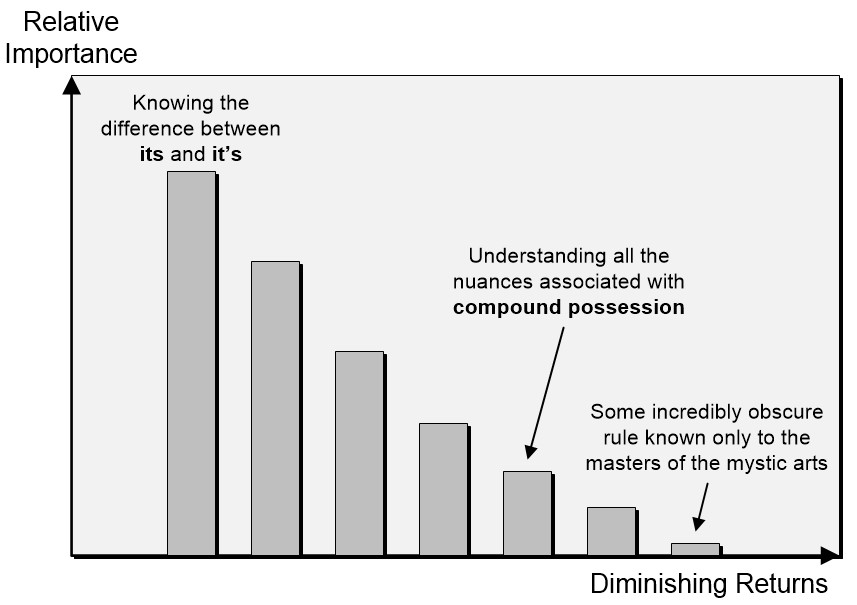In recent columns (see Using USB4? Require ReTiming? Kandou Can-Do! and Just Call Me an Indexing Fool), I’ve made mention of the fact that I’m in the process of writing a book called Wroting Inglish: The Essential Guide to Writing English for Anyone Who Doesn’t Want to be Thought a Dingbat.
As I previously noted, the primary intent of this tome is to explain grammar and punctuation to engineers in a fun and interesting fashion. Did you ever read Eats, Shoots & Leaves: The Zero Tolerance Approach to Punctuation by Lynne Truss? Who would have guessed that this would become an international bestseller? I can but hope that when I eventually pass the finishing post (this is a back-burner hobby project), my own modest efforts will enjoy similar success.

The image I plan on using on the cover of Wroting Inglish features a supercilious wonder who thinks he knows it all (but he doesn’t) (Image source: Max Maxfield)
So, why did I decide to plunge into this particular odyssey, you may ask. Well, as I say in the book, in one of my past positions, when I was acting as the Editor-in-Chief for an online technical publication, I used to receive a humongous number of emails each day, along with a plethora of article submissions. You would not believe some of the things I saw, including spurious thoughts, run-on sentences, and hopelessly mixed tenses, all combined with the most graunching grammatical errors and problematic punctuation. In some cases, my correspondents may not have been native English speakers, but it was not uncommon to see eye-watering errors from folks in America, Australia, or even the home country itself.
There’s an old saying that goes, “You get only one chance to make a first impression.” This is certainly true, although it is perhaps more germane to say, “You get only one chance to make a good first impression!” Suffice it to say that if someone sends me an email saying, “Your an idiot,” (this should, of course, be “You’re an idiot” or “You are an idiot”), then the chances are fair-to-middling they are not conveying the message they were perhaps aiming for (although it’s certainly fair to say that they managed to make a first impression).
I have engineer friends around the world, many of whom are brilliant on the technical front but who are let down by their writing skills. I cannot tell you how many of them appear unable to differentiate between “its” and “it’s” or “your” and “you’re,” and don’t even get me started on their mistakenly employing apostrophes when trying to indicate a plural, using “FPGA’s” instead of “FPGAs,” for example. And it’s not just engineers; many of the communications I receive from doctors, lawyers, and other professionals are riddled with such elementary errors that it’s hard to know whether to laugh or cry.
The bottom line is that it doesn’t matter whether you are just starting your career or if you are a pillar of professional society, if you write like a dingbat, people will snigger behind your back and cast aspersions.
There are, of course, countless books that explain English grammar and punctuation in excruciatingly nit-picking detail, so how can it be that so many people are so bad at writing things down? On the downside, English is a tricky language with myriad convoluted conventions and regulations. On the upside, there are a few simple rules and ways of doing things that are easy to learn and that will make a huge difference to the way in which one’s writings are perceived. Consider the extremely complicated technical chart shown in Figure 1-1 from the book (used by kind permission of myself).

Illustration from Wroting Inglish (Image source: Max Maxfield)
I think this proves beyond a shadow of doubt that readers of my book will reap a huge return-on-investment by spending only a little time learning a few core concepts. By comparison, it could be argued that they would gain little advantage from devoting years of painstaking effort to master some convoluted sentence construction that they would probably never actually use, and that their readers would fail to appreciate even if they did.
In an ideal world, of course, it would be wonderful to understand everything there is to know about everything, but if we acknowledge that the majority of my readers’ interest in grammar and punctuation is minimal at best, then we are obliged to prioritize. In my case, for example, the primary audience for my writings is engineers, the majority of whom wouldn’t recognize a split infinitive or a dangling participle if one were to crawl up their leg and bite them on a very unfortunate portion of their anatomy.
The bottom line is that it is not the intention of my book to teach everything there is to know about English grammar and punctuation. Instead, I intend to ponder only a sprinkling of the really important points that will make my readers look extremely silly if they get them wrong.
The main body of the book is going to be composed of around 50 chapters. Don’t Panic! Each of these chapters will address a single simple topic and be only a couple of pages long. Let’s take the chapter on “Its” versus “It’s,” for example. You may think that you know all there is to know about this topic, but I may manage to surprise you with the odd nugget of knowledge or tidbit of trivia. The remainder of this column is taken directly from this chapter. After you’ve perused and pondered the writings below, I’d be very interested to hear what you think.
It’s a Crying Shame
As we noted earlier in this book, its and it’s each have only three letters, and the same three letters at that, so it wouldn’t appear to be beyond the bounds of possibility that we can master the correct usage of these little scamps. That’s why it’s such a crying shame that so many people manage to mix them up.
Of course, it may be that some people simply don’t think this is important. Trust me; they are wrong. If you are wading through the childlike scribblings of someone who misuses its and it’s, the effect is akin to stubbing a metaphorical toe because it makes your metaphorical eyes water (this does, of course, assume that you know the difference yourself). It also leaves you thinking something along the lines of “What a drongo!” (where “drongo” is Australian / New Zealand slang for a stupid or incompetent person). The sad thing is that the author of the work you are reading may well be extremely intelligent and articulate, but their sub-standard writing skills negatively impact your impression of them.
Fear not. We will not allow you to become one of their number. Together, we will learn how to make these itsy-bitsy three-letter words bend to our will. Let’s start by noting that, in the same way the pronouns he and she have the possessive forms his and her, respectively, so the pronoun it has the possessive form its. This allows us to say things like:
This chair has lost its leg.
That squirrel has misplaced its nuts.
The car lost its power.
The committee published its decision.
The important thing to note is that this is different to the way in which we form the possessives of nouns. Singular nouns form their possessives using ’s (that is, an apostrophe followed by an s); for example:
The dog’s dinner… (A feast belonging to the dog)
The boy’s ukulele… (A ukulele belonging to the boy)
Meanwhile, plural nouns ending in s form their possessives by simply adding an apostrophe; for example:
The cats’ soft toy… (One soft toy belonging to a clowder of cats)
The cats’ soft toys… (Multiple soft toys belonging to multiple cats)
The girls’ chainsaw… (One chainsaw shared by a gaggle of girls)
The girls’ chainsaws… (Multiple chainsaws owned by some scary girls)
As we discussed above, however, in the case of the third-person, singular, neuter pronoun it, we simply add s to form the possessive its. To put this in a nutshell, its is a possessive pronoun that is the neuter version of his and her and pretty much means “of it” or “belonging to it.” By comparison, it’s, with an apostrophe, is a contraction for it is or it has; for example:
Well, it’s a mystery to me. (Contraction of it is)
It’s been great to meet you. (Contraction of it has)
One reason for the confusion between its and it’s — where such confusion is far more common than you might think — is that, in the case of nouns, the ‘s form (an apostrophe followed by an s) is successful in covering both the possessive and the contraction cases; for example:
Harry’s hat is on his head. (Possessive: The hat belongs to Harry)
Harry’s going to the pool. (Contraction of Harry is)
How do we manage to tell the difference between these two flavors of Harry’s? Well, we do it from the context because we are incredibly clever at things like that. On this basis, you might be forgiven for wondering why it’s shouldn’t follow the same rule – that is, to act both as a possessive and a contraction and leave it up to the reader to decide the actual meaning from the context. “Impossible!” you cry? Well, we manage to do it with the spoken word without any difficulty, don’t we?
Good-For-Nothing Grammarians
Actually, things aren’t quite as clear-cut as you might suppose. Let’s start by reminding ourselves that there are seven possessive pronouns in modern English: mine, yours, his, hers, its, ours, and theirs (in the past, folks also employed the word thine, meaning yours, but we don’t tend to see this usage anymore, which is a shame because I rather like it).
The way in which possessive pronouns were used remained something of a muddle until around the beginning of the 1800s. Prior to that time, some folks used apostrophized forms while others favored un-apostrophized versions. In fact, the contraction of it is used to be the word tis, while it’s was commonly used as the possessive of it – the exact opposite of the way we do things today!
Later, as the use of the word tis faded away, it’s was increasingly used to represent both the possessive and the contraction, leaving it up to the reader to determine the meaning from the context. Eventually, sometime during the early part of the 19th century, those good-for-nothing grammarians settled on the somewhat arbitrary decision that its would be used to represent the possessive while it’s would be used to represent the contraction. And that’s where things stand today. (If I ever manage to finish building my time machine, there are a number of grammarians who are going to be very unpleasantly surprised, let me tell you.)
Remembering that language is an evolving beast, we should be prepared to acknowledge that the pendulum may swing, and it’s not beyond the bounds of possibility that things may change again in the future. At the time of this writing, however, all we need to do is to remember the following:
It’s (with an apostrophe) is the contraction meaning it is or it has.
Its (without an apostrophe) means “of it” or “belonging to it.”
Useful Tip: Deciding Which One to Use
If you are ever unsure — after you’ve written a sentence containing its and/or it’s — as to whether or not you’ve got things right, there are two simple tests you can perform as follows:
- If you can replace its with her or his and your sentence still works grammatically (if not logically), then you are OK using its; otherwise replace it with it’s.
- If you can replace it’s with it is or it has and your sentence still makes sense, then you are OK using it’s; otherwise replace it with its.
Congratulations! Henceforth, you should no longer have any trouble writing or decoding a sentence like: It’s a hot and sticky day and my dog is scratching its ears, which means it’s going to rain.






its not good to get ptoo obediant to a langwidge that insists on arbitrary nonsense in its written form….even with, English is entirely adequate for myself, and I’m really suspicious of efforts to *improve* it, maybe make it more equitable at the expense of the ability to precisely communicate an idea….if a phonetic spelling does not sacrifice unique meaning, stick it to the man!!
The thing is that it sort of improves itself — for example, irregular verbs are evolving over time to become regular.
From a guy who took three tries to get through English 101. (Lack of attention?) And is at all times saved by a robust spell checker.
It never ceases to amaze me what our institutions of “higher learning” is turning loose on the world now days. If it wouldn’t be extremely boring I would like to be a fly on the wall in one of today’s English 101 classes. (So far the spell checker has saved my bacon at least six times 🙁 )
I visit someplace like Craig’s List and see many items, “For Sell”! Worse I see the same atrocities as this as well as, “its and it’s” on many on line “social” sites that are haunted mostly by so called “Collage Graduates” and many are not even Engineers!
Good lord, they should at least turn on their spell checkers! Of course that won’t save them from the likes of “Sell” and “Sale” and “to”, “too” and “two”. (Don’t question my punctuation please. My spell checker just ain’t that good.)
I come from a time of experimentation — when I was a kid, the idea was that it didn’t matter how you spelled things, the important part was to express yourself — they planned on retro-fixing your spelling capabilities later. Of course it was a dismal failure — I agree that spelling checkers (and grammar checkers) are a boon — but some of the things like the difference between “your” and “you’re” shouldn’t be beyond the grasp of a university student (even those from Texas 🙂
Well horror of horrors my institutional degree is actually from the University of Arkansas. But I got to Texas as fast as I could. The old state moto is, “The Land of Opportunity”. I took that to mean, “At the first opportunity, leave.” 🙂 Pretty place, but it ain’t Texas.
Hi Max,
Have you got a copy of Gwynne’s Grammar? Well worth a read. Engineering depends on its success for clear and precise communication – are we working in metric or imperial measurements NASA?
Just don’t get me started – this is one of the bees in my bonnet, a pet peeve, a hobby-horse.
Good to see you taking up this issue – thanks.
I hadn’t heard of “Gwynne’s Grammar” but I just ordered a copy from Amazon — my old English teacher is rolling over in her grave at the thought of my writing a book on Grammar and Punctuation — but I actually think I can bring something new to the party — all I have to do is finish writing the book LOL